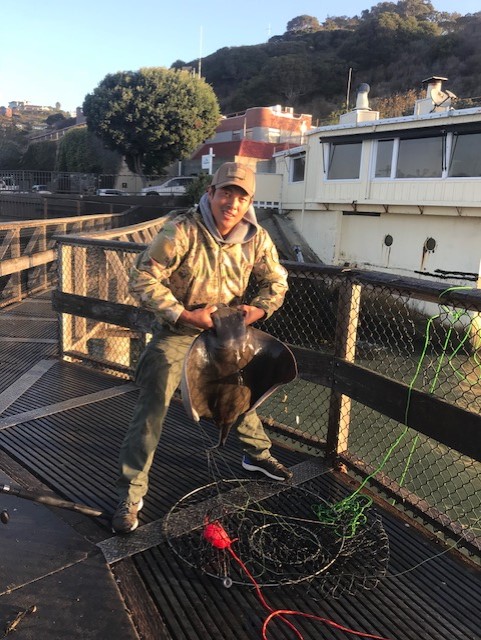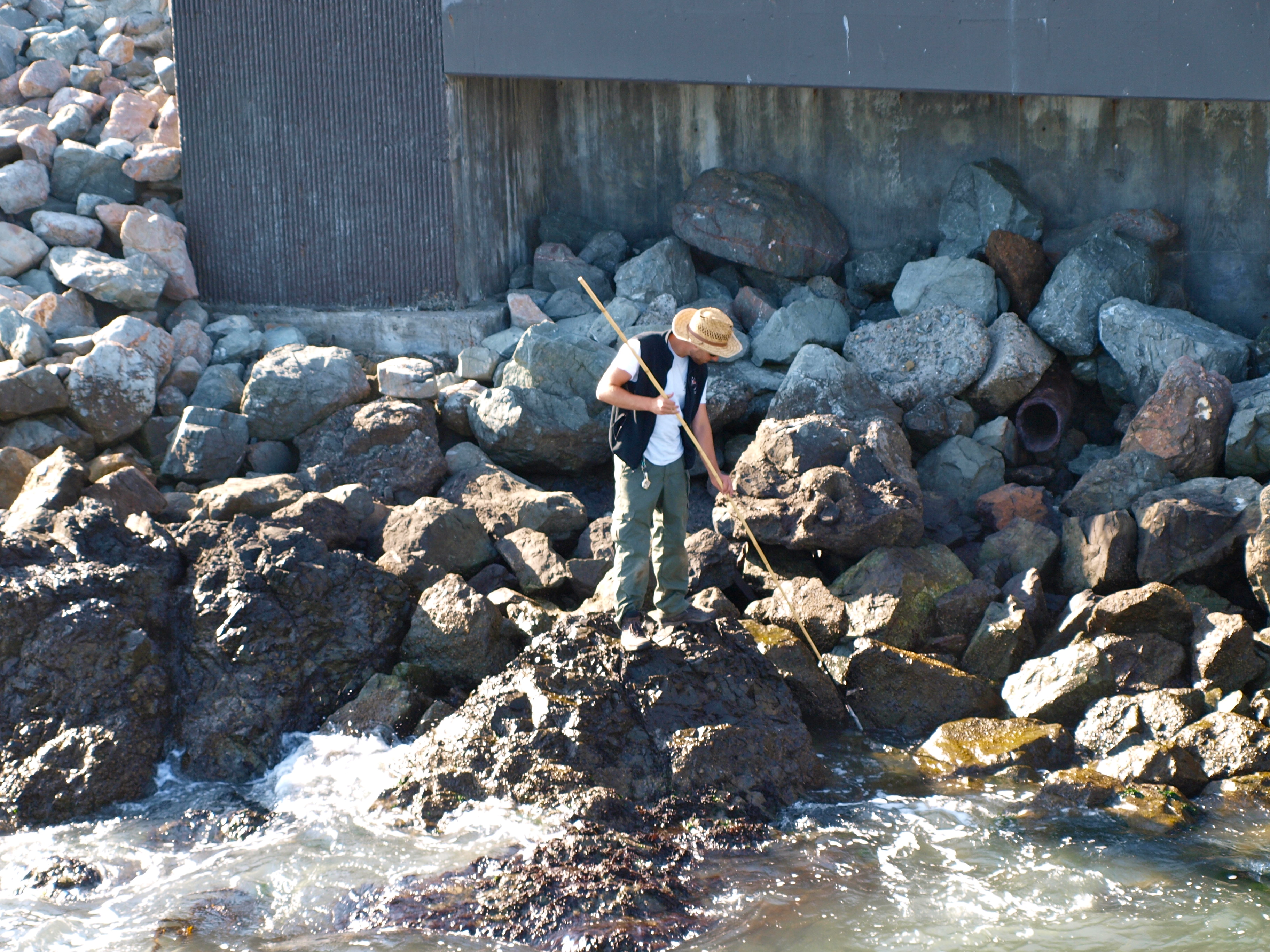Arrived with the incoming tide topping out and slacking, which is good for this pier due to the strong current in the channel and the snaggy bottom that all sinkers seem to catch when the tide is outgoing. Instantly started hooking brown rockfish, with most of them being hand-sized and smaller. One very interesting catch was a baby octopus that latched onto an anchovy. It was the first time in my life I have ever hooked one and it was really neat to handle it a little and watch his behavior in the water bucket. My compassion for the little guy overcame my desire to use him for lingcod bait, and much to my wife’s delight, I set him free. Small child and his mom came out to crab and fish and they did well with some red rock crabs. I was impressed with the youngsters fishing knowledge and integrity; he reminded me of myself at his age. I helped to show him some new knots and gave him some of my pre-tied rigs to use in the future and he and his mother were thankful and delighted. Planting the positive seeds for the future.
Another man came out and was fishing for jacksmelt to use as lingcod bait in Bodega Bay. He ended up filling a whole bucket in about an hour. Left at around 1730 to grab some food in SF.
We spent the night in Marin and wagered whether or not to fish again. I decided to give it one last go with the rest of the anchovies that had died (and I had kept on ice overnight). Hit the pier at dawn and immediately tied into a couple of rays. The bigger one was 42lbs and put up a hell of a fight with the strong incoming tide.

Matt Shockley and a bat ray
Released both rays and started hooking rockfish and rock crab. Managed to nail 5 healthy keeper male crabs on my anchovy rod, so I decided to keep them so the wife could make her famous ‘Crab Udon Noodle’ dish. Switched one rod over to a salmon trolley rig. I knew it was a long shot since recent fishing news had reported the salmon bite at Cal City being slow, and there were about a dozen sea lions swimming around, but what the heck. Continued to catch some sporadic jacksmelt and rockfish for the next two hours, with the salmon trolley being quiet the whole time. The tide slacked out and I started to re-rig with a heavier set up on my active rod when I looked up just in time to see the tip of my salmon rod slightly “pop.” My eyes instantly shot out to my apple bobber, and within 3 seconds it submerged, and started dragging, and popping out to the channel. I started cranking away like a mad man, thinking that I may have hooked a rogue striped bass…but when the weight finally caught up to the leader and the fish took off, I knew immediately that I had hooked a salmon. It tore off about 35 yards of line like a bat out of hell, with tail walking and jumping headshakes. I was praying that my circle hook was lodged well since I was still suffering my PTSD from the halibut loss last week. Finally had him tired out and in the hoop net, and with the help of my wife, we hauled in a fat, 6lb. salmon. I’ve never seen a circle hook lodge into a salmon jaw and go through the eye, but that is where I had him, so he must have dove hard on the initial hookset.

Matt Shockley and a salmon
Finally, a little redemption for my efforts of the past month or so. The last time I landed a salmon from a pier was back in 1999 so this was really something for me. All the money spent on gas/bait/food/lodging, mileage on the car, man hours fishing, and near fanatical devotion had finally paid off. Left tired and happy at about 1230 to head back up to Reno and treat my wife to a nice dinner and foot massage since she puts up with me and my near psychotic addiction to pierfishing.


This is one of the few piers where you might see an angler “poke poling” for fish.
<*}}}}}}}}}>< — This pier is located in an extremely nice area, an upscale touristy area, and an area that receives considerable crowds. Weekend parking can be at a premium so if possible arrive early or late in the day, especially on summer weekends. If just visiting, you might want to take the ferry.

The ferry Del Norte
<*}}}}}}}}}>< — Angel Island, just across the strait from the pier is today a state park, one that is well worth a visit. Ferries run from several different areas but primarily from Tiburon itself and the landing is just a short distance away from the pier. The island served at one time as the West Coast entry point for people wishing to enter the United States. It’s not as popular a tourist spot as Ellis Island and the Statue of Liberty in New York, but you can still see where the people, mainly from Asia, were examined and sometimes held while determination was made on their entry. Several building still stand and give a glimpse into an interesting past. However, most people seem to simply head over to Ayala Cove, its picnic areas, and the hiking trails that lead throughout the small island. There’s even a pier that can be fished!

History Note. The name of the town comes from the Spanish Punta de Tiburon (Shark Point). It should not be a surprise therefore that this is an excellent spot to fish for leopard shark and brown smoothhound shark.
Elephant rock itself, apparently in reference to its shape and size, was early on (in an 1850 map) called “Pulpeti de Padre,” or Father’s Pulpit.
As mentioned, the area is an extremely nice tourist area with manicured lawns adjacent to the bluffs, nice landscaping, good parking areas, and an attractive shopping area on the nearby Main Street. It is hard to imagine that up until the 1960s this was basically a railroad town. The railroad controlled most of the area and tracks ended just across the street from the pier where the parking lot sits today. In fact, a newspaper article in 1950 characterized Tiburon as “a bundle of tracks and a clump of smoky buildings and 42 Acres of land…a workshop of noise, oil, welding, and hammering.” The shoreline was dominated by commercial activity with ferry slips and cargo wharfs covering much of the beach area between Elephant Rock and the Main Street part of Tiburon.
Passenger use of the area did decline in 1907 when the SF&NP merged with the North Shore Railroad to become the Northwestern Pacific Railroad. Although a smaller passenger ship continued to run to Belvadere and Tiburon, ferry service shifted to Sausalito while the Tiburon shoreline was primarily used for cargo shipping. The opening, in 1937, of the Golden Gate Bridge signaled that the end was near for the north bay ferries and just five years later, in 1942, the Sausalito to San Francisco ferry ended operation. Cargo operations continued until the 1960s but by 1958 most operations had ceased and Southern Pacific (the parent company since 1929), had shifted operations elsewhere. In 1967 the last train ran out of Tiburon and the change began.
In 1984, 20,000 cubic yards of soil containing oil and lead from the railroad operations were removed and replaced by clean fill. Next, a 38-acre site was leveled for the expensive and beautiful condominium complex called Point Tiburon. The only reminder today of the railroad years is pictures and the old railroad depot. Just up the street from the pier sits the Donahue Building, the building that once was known as the Tiburon Depot.
The pier was built in 1961 in memory of a young, 11-year-old boy who had drowned after slipping from a nearby railroad pier. Unwilling to wait for permits, local residents built the pier, and, as mentioned, dedicated it to “girls and boys under 16 years of age who love to fish.”
Wave damage led to the closure of the pier in 1996. Waves had uplifted and damaged the old wooden platform that surrounded the rock. In addition, the steep walkway out to the pier needed repair. Unfortunately, fixing the pier in the ‘90s was not as easy as building the pier back in the ‘60s. The city needed federal money to repair the pier and the resulting legal entanglements would lead to a long, three-year ordeal before the pier was repaired and opened. In order to satisfy the requirements of the American Disabilities Act, the switchback ramp to the pier that you see today was created. In addition, to prevent future damage from waves, a new steel grid was used instead of wood around the rock. It gives the pier a somewhat colder feeling, and allows an occasional bath from the waves, but it is designed to dissipate force from the waves and thus hopefully, prevent damage. Because of the legal requirements and paperwork, the less than 100-foot-long pier, and its fancy new ramp, was not opened until the summer of 1999.




<*}}}}}}}}}>< — Special Bay Area Regulations:
- A perch closure exits in San Francisco and San Pablo Bay from April 1 to July 31. No perch may be kept other than shinerperch (20).
- In San Francisco and San Pablo Bay a fishing line may not contain more than three hooks.
Sturgeon Regulations:
- A sturgeon report card and tags are required for anyone fishing for or taking sturgeon. (a) The card must be in the angler’s possession; (b) a tag must be used for any sturgeon retained by the angler; (c) the angler must record information on the Sturgeon Report Card immediately after catching and keeping or releasing the sturgeon.
- White sturgeon can only be kept from 40-60 inches; larger and smaller sturgeon must be released.
- Green sturgeon may not be taken or possessed.

Elephant Rock Pier Facts
Hours: Open one hour before sunrise to one hour after sunset.
Facilities: There is some free parking just across the street from the pier — two hours only from 8 A.M. to 6 P.M. There is additional parking down the street or on residential streets. There are no lights, fish cleaning stations or restrooms. The upscale Caprice Restaurant is located at the foot of the pier.
Handicapped Facilities: This is not the best of sites for handicapped anglers. There are some handicapped parking spaces in the lot across the street from the pier but the ramp leading down to the pier is fairly steep and narrow and the walkway around the pier itself is also narrow. The railing is approximately 40 inches high.
How To Get There: From Highway 101 take the Tiburon exit west and follow Tiburon Boulevard (State Highway 131) to Paradise Drive where you will see the pier. The pier is at the corner of Paradise Drive and Mar West Street.
Management: Tiburon Public Works Department.
